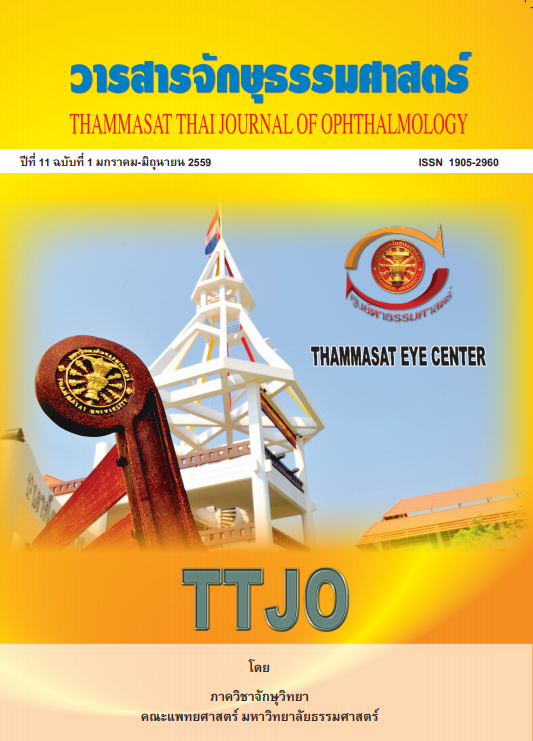แนวทางการรักษาผูปวยโรคจุดภาพชัดบวมของจักษุแพทย สาขาจอตา ในประเทศไทย
Main Article Content
Abstract
บทคัดยอ
วัตถุประสงค: เพื่อศึกษาแนวทางการรักษาผูปวยโรคจุดภาพชัดบวมจากเบาหวาน (diabetic macular edema) และ จุดภาพชัดบวมที่เกิดจากเสนเลือดดําจอประสาทตาอุดตัน (retinal vein occlusion) ของจักษุ แพทยสาขาจอตาในประเทศไทย
แบบแผนของการวิจัย: การวิจัยเชิงพรรณนา
วิธีการศึกษา: ไดทําการศึกษาในชวงเดือนกรกฎาคม 2556 โดยการสงแบบสอบถามทาง e-mail ใหกับจักษุ แพทยสาขาจอตา จากชมรมจอตา ราชวิทยาลัยจักษุแพทยแหง ประเทศไทย (Thai Retina Society) ทั้งหมด 106 คน มีผูตอบแบบสอบถามและ สงกลับมาทั้งหมด 37 คน (34.9%) โดยแบบสอบถามเกี่ยวกับวิธีการรักษา โรคจุดภาพชัดบวมที่เกิดจาก diabetic macular edema (DME) และ macular edema ที่เกิดจาก retinal vein occlusion
ผลการศึกษา: ผูปวย DME ที่มี microaneurysms อยูนอก foveal avascular zone (FAZ) นั้น จักษุแพทย สาขาจอตาสวนใหญ เลือกวิธีการรักษาโดยวิธี macular photocoagulation (59.5%) สวนผูปวย DME ที่มี microaneurysms อยูใน FAZ และ DME ที่มี ลักษณะ diffuse นั้น จักษุแพทยสาขาจอตาสวนใหญเลือกวิธี ฉีด intravitreal antivascular endothelial growth factor (83.8%) ในผูปวย macular edema ที่เกิดจาก central retinal vein occlusion และ branch vein occlusion นั้น จักษุแพทยสาขาจอตาสวนใหญ เลือก วิธีฉีด intravitreal antivascular endothelial growth (81.1% และ 48.6%) ในการรักษา
สรุป: การศึกษานี้แสดงใหเห็นถึงความหลากหลายในการเลือกวิธีการรักษา DME และ macular edema ที่ เกิดจาก retinal vein occlusion ของจักษุแพทยสาขาจอตาในประเทศไทย ซึ่งมุงเนนไปที่การใชยากลุม antivascular endothelial growth factor
Practice patterns of retina specialists in the treatment of macular edema in
Thailand
Abstract
Objective: To perform a survey of the Retina Specialists regarding the practice patterns in treatment of diabetic macular edema and macular edema secondary to retinal vein occlusion in Thailand.
Design: Descriptive study Materials and
methods: Questionnaires were distributed to 106 retina specialists via e-mail during July 2013. Data received from 37 (34.9%) respondents were assessed and analyzed. Retina specialists were asked about their treatment modalities in diabetic macular edema (DME) with microaneurysms (MA) within the foveal avascular zone (FAZ), DME with MA away from the FAZ, DME with diffuse thickening, central retinal vein occlusion (CRVO) with macular edema and branch retinal vein occlusion (BRVO) with macular edema.
Results: In DME patients with microaneurysms outside the foveal avascular zone (FAZ), the majority of retina specialists chose macular photocoagulation (59.5%), in contrast, in DME patients with microaneurysms inside the FAZ zone, retina specialists chose intravitreal antivascular endothelial growth factor (anti-VEGF) injection (83.8%). On the other hand, in cases of macular edema due to central retinal vein occlusion and branch vein occlusion, most retina specialists preferred intravitreal anti-VEGF injection (81.1% and 48.6% respectively).
Conclusion: This study showed a variety of treatment methods used by Thailand-based retina specialists for cases of diabetic macular edema and macular edema secondary to retinal vein occlusion. The use of intravitreal antivascular endothelial growth factor injections is the most common choice of treatment in Thailand.
Article Details
References
Early Treatment Diabetic Retinopathy Study Research Group. Photocoagulation for diabetic macular edema: early Treatment Diabetic Retinopathy Study Report Number 1. Arch Ophthalmol. 1985;103:1796-806.
Early Treatment Diabetic Retinopathy Study Research Group. Treatment techniques and clinical guidelines for photocoagulation of diabetic macular edema: early Treatment Diabetic Retinopathy Study Report Number 2. Ophthalmology. 1987;94:761-74.
Branch Vein Occlusion Study Group. Argon laser photocoagulation for macular edema in branch retinal vein occlusion. Am J Ophthalmol. 1984;98:271–282.
Striph G, Hart W, Olk J. Modified grid laser photocoagulation for diabetic macular edema. The effect on the central visual field. Ophthalmology. 1988;95:1673-9.
Lovestam-Adrian M, Agardh E. Photocoagulation of diabetic macular edema— complications and visual outcome. Acta Ophthalmol Scand. 2000;78:667-71.
Early Treatment Diabetic Retinopathy Study Research Group. Focal photocoagulation treatment of diabetic macular edema: relationship of treatment effect to fluorescein angiographic and other retinal characteristics at baseline: ETDRS report no 19. Arch Ophthalmol. 1995;113: 1144-55.
Gillies MC, Sutter FK, Simpson JM, et al. Intravitreal triamcinolone for refractory diabetic macular edema: two-year results of a double-masked, placebo-controlled, randomized clinical trial. Ophthalmology. 2006;113: 1533-8.
Ozkiris A, Evereklioglu C, Erkilic K, Dogan H. Intravitreal triamcinolone acetonide for treatment of persistent macular edema in branch retinal vein occlusion. Eye. 2006;20:13– 17.
Jonas JB, Akkoyun I, Kamppeter B, Kreissig I, Degenring RF. Branch retinal vein occlusion treated by intravitreal triamcinolone acetonide. Eye. 2005;19:65–71.
Ip MS, Scott IU, VanVeldhuisen PC, Oden NL, Blodi BA, Fisher M, Singerman LJ, Tolentino M, Chan CK, Gonzalez VH; SCORE Study Research Group. A randomized trial comparing the efficacy and safety of intravitreal triamcinolone with observation to treat vision loss associated with macular edema secondary to central retinal vein occlusion: the Standard Care vs Corticosteroid for Retinal Vein Occlusion (SCORE) study report 5. Arch Ophthalmol. 2009 Sep;127(9):1101-14.
Jonas JB, Degenring RF, Kreissig I, Akkoyun I, Kamppeter BA. Intraocular pressure elevation after intravitreal triamcinolone acetonide injection. Ophthalmology. 2005;112:593–598.
Mitchell P, Bandello F, et al. The RESTORE study: ranibizumab monotherapy or combined with laser versus laser monotherapy for diabetic macular edema. Ophthalmology. 2011 Apr;118(4):615-25. 13. Michaelides M, Kaines A, Hamilton RD, et al. A prospective randomized trial of intravitreal bevacizumab or laser therapy in the management of diabetic macular edema (BOLT study) 12-month data: report 2. Ophthalmology. Jun 2010;117(6):1078-1086.e2.
Campochiaro PA. Safety and efficacy of intravitreal ranibizumab (Lucentis) in patients with macular edema secondary to branch retinal vein occlusion. The BRAVO Study. Paper presented at The American Society of Retina Specialists Retina Congress, October 4, 2009; New York.
Rabena MD, Pieramici DJ, Castellarin AA, Nasir MA, Avery RL. Intravitreal bevacizumab (Avastin) in the treatment of macular edema secondary to branch retinal vein occlusion. Retina. 2007;27:419–425.
Varma R, Bressler NM, Suner I, Lee P, Dolan CM, Ward J, et al. Improved Vision-Related Function after Ranibizumab for Macular Edema after Retinal Vein Occlusion: Results from the BRAVO and CRUISE Trials. Ophthalmology. 2012 Jul 17.
O’Doherty M, Dooley I, Hickey-Dwyer M. Interventions for diabetic macular oedema: a systemic review of the literature. Br J Ophthalmol. 2008;92:1581-90.
Brown DM, Michels M, Kaiser PK et al. Ranibizumab versus Verteporfin photodynamic therapy for neovascular macular degeneration: two-year results of the ANCHOR study. Ophthalmology 116, 57–65 (2009).
Lalwani GA, Rosenfeld PJ, Fung AE et al. A variable-dosing regimen with intravitreal ranibizumab for neovascular age-related macular degeneration: year 2 of the PrONTO Study. Am. J. Ophthalmol. 148, 43–58 (2009).
Varma R, Bressler NM, Suñer I, Lee P, Dolan CM, Ward J, et al. Improved Vision-Related Function after Ranibizumab for Macular Edema after Retinal Vein Occlusion: Results from the BRAVO and CRUISE Trials. Ophthalmology. Jul 17 2012.
Branch Vein Occlusion Study Group. Argon laser photocoagulation for macular edema in branch vein occlusion. The Branch Vein Occlusion Study Group. Am J Ophthalmol. Sep 15 1984;98(3):271-82.


